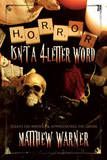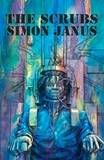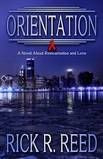Suckers / J.A. Konrath and Jeff Strand
 Delirium Books / May 2008
Delirium Books / May 2008
Reviewed by: Michele Lee
Suckers is the sixth book in the Delirium Books hardcover chapbook series, a crossover tale featuring Konrath's sexist bad boy Harry McGlade and Strand's infamous Andrew Mayhem. Ninety six pages of pure action and insanity, it starts with Andrew Mayhem, a bit battered, running to the store to get mushroom-free spaghetti sauce. On the way, he runs into McGlade who is breaking into a neighborhood house looking for a missing girl.
The ensuing mess is part action/adventure (complete with a mystery to be solved and a girl to be saved!), part horror (a cult of murderous vampires!) and part pure egotism (Harry McGlade starring as The Chosen One?!). Konrath and Strand both break the rules of writing and leap past the boundaries of genre borders with casual ease. But they can be depended on for highly entertaining, hilarious tales with enough splatter to keep readers’ attention and enough thrills to leave readers satisfied after all is said and done.
While other writers focus on writing an opus that will withstand the tests of time, Strand and Konrath are both joyful midlisters, endowing them in some ways with a freedom from the traditions of mainstream publishing careers. The wildness of Suckers is a testament to the strength of both contributing writers and the addictiveness of their prose.
Despite gore, violence, cheesy jokes and a plotline that seems too bizarre to ever make it in even the fictional world, Suckers will not be enough of Strand and Konrath for readers. This cute little chapbook is a mere sample-size serving that could lead readers into an all out binge.
Purchase Suckers by J.A. Konrath and Jeff Strand.
Horror Isn't a Four-Letter Word / Matthew Warner
 Guide Dog Books / September 2008
Guide Dog Books / September 2008
Reviewed by: Martel Sardina
Books on writing are a dime a dozen, so why should anyone feel compelled to buy this one? The answer is simple. Each author brings their unique insights and experiences to the table, and Matthew Warner is no exception.
Horror Isn’t a 4-Letter Word is a collection of Mr. Warner’s editorial essays originally written for the Horror World website and a few articles from the Hellnotes Newsletter.
From his humorous look at why an aspiring writer might not want to hone his craft on company time to more serious matters, like his internship at Edit Ink, Warner covers a variety of topics that will interest not only genre writers but also fans and those who may be curious about the inner workings of the publishing industry.
This reviewer (who also writes fiction) found Warner’s essays on the craft of writing useful. In his essay on dialogue, Warner gives examples from other author’s published works, explains the error(s) made, and then proposes edits that improve the quality and/or pacing of the selected excerpt.
As a writer, have you ever wondered how to solve plotting problems? Warner suggests, “character is the best plot.” Using the Buffy the Vampire Slayer series as an example to prove his point, Warner states “The Buffy characters necessarily became as complex as the plots because the long-term conflicts were about the characters.” Problems with plot can be resolved by linking character-based sub-plots under temporary dilemmas. Another technique that writers may find helpful is having the conflict unfold over multiple episodes or chapters, making sure to end on a cliffhanger to keep the reader wondering “What will happen next?” and ensure that they will come back for more.
“With the Eyes of a Writer” is the craft-related essay that this reviewer found most insightful. The preceding essay entitled “With the Eyes of God” is a short story that Warner was commissioned to write for the fiction section of the Horror World website. The story ends in a manner that Warner did not originally anticipate. Knowing his editor’s preferences in terms of violence, Warner doubted the piece would be accepted.
In “With the Eyes of a Writer,” Warner dissects the story, explaining how he came to write the piece. Warner includes visual aids, showing the entry of the original “seed” of an idea in his journal. He discusses his outlining, writing and revision process. This essay is chocked full of good advice and backed up with the details of how Warner applied that advice to his own work. It also has a happy ending. The story was accepted despite its violent content because Warner handled the content with the respect it deserved.
Warner shares some personal, non-writing related experience over the course of the collection. While some may not be interested in the details of his personal life, Warner finds a way to tie those experiences back to writing in some way. While this reviewer knew the story of Warner’s first run-in with his future mother-in-law would no doubt be entertaining, discovering what that meeting taught Warner about being a storyteller made the tale even more enjoyable.
Warner’s eclectic tastes represent his journey as a student, a writer, a businessman and a husband. While this collection of essays is geared more toward horror writers, Warner’s conversational writing style will keep non-writers interested and that the lessons learned here can be applied to other walks of life.
Pre-Order/Purchase Horror Isn’t a Four-Letter Word by Matthew Warner.
The Scrubs / Simon Janus
 Bad Moon Books / July 2008
Bad Moon Books / July 2008
Reviewed by: Jeff Burk
Simon Janus is the pseudonym of thriller author Simon Wood (We All Fall Down, Paying the Piper). The Scrubs is his first horror novel and the premier of this new horror-writing persona. So how does Wood/Janus fair at this new venture?
Wormwood Scrubs is a prison in London that offers its inmates much more than three square meals a day and time for reflection on past crimes. Prisoners can opt to take part in a special program called “The North Wing Project”, in which they’re sent into the mind of a serial killer. Survive this super-secret military experiment and a full pardon is theirs. Michael Keller has just volunteered for the program and soon lives to regret it.
A team of scientists have managed to open a portal directly into the brain of James Jeter, a deranged serial killer. Two other prisoners have gone through the portal – called “The Rift” - but never came back. Keller's assignment is to enter “The Rift”, document what he finds, and learn the identity of Jeter’s last victim as well as what happened to the other two prisoners.
The surreal world of abstract horrors that awaits Keller will thrill many readers of dark genre fiction. Janus shows us bizarre sights rarely seen in mainstream horror. It’s just a shame he doesn’t really go anywhere with it. By the end of the novella, the reader is left with many more questions than answers - and not in a good, mystery-kind-of-way. The Scrubs could have benefitted from at least another hundred pages or so to make the experience truly satisfying.
Of particular note is the construction of the book. The book begins with an introduction explaining to the reader that Simon Janus is actually Simon Wood. In his afterword, Janus points out that Wormwood Scrubs is based on a real prison in West London (yes, the name is real too), but the one appearing in the story is (thankfully) fictional. While seemingly odd at first for the author to create this fake history and go to great lengths to make the reader aware that they are indeed fake, these little sidebars reinforce the main idea of imagination becoming reality and vice versa from the story itself.
The Scrubs is an ambitious first work of horror and suffers a bit at times for it. One cannot find fault in the characters or the writing, but these aspects quickly become lost in the strange, albeit inventive, multi-reality story. The author promises in the afterword that Wormwood Scrubs is just the first story in the Wormwood universe. Here's hoping that future books will deliver on the promise evident in The Scrubs.
Purchase The Scrubs by Simon Janus.
Orientation / Rick R. Reed
 Amber Quill Press / May 2008
Amber Quill Press / May 2008
Reviewed by: Martel Sardina
Orientation opens with Robert’s heart wrenching loss of his lover, Keith on Christmas Day 1983. Robert and Keith’s whirlwind May/December romance is cut short when Keith is diagnosed with a strange new disease that some call the “gay cancer.” Robert, a young idealist, is devastated not only by Keith’s loss but also by accusations that his only motivation for being in a relationship with an older man was greed. While Robert did inherit Keith’s estate, he would’ve gladly given it all up to get his soul mate back.
Now, twenty-four years later, the tables have turned and Robert is now the “Daddy” in a relationship with a much younger lover, Ethan. It is Christmas Day 2007 and Robert wonders why he continues to tolerate Ethan’s erratic behavior. Ethan stands Robert up on the day when he is needed most. Despite all the years that have passed, Robert has never gotten over losing Keith.
As Robert’s frustrations rise, he decides to take a late night walk along Chicago’s lakefront in order to clear his head. While there, he prevents a young woman from committing suicide. He convinces the woman, Jess, to come home with him, offering her companionship and a safe place to stay until she can get her head together. While Jess is skeptical, thinking that Robert may have ulterior motives, she agrees to the proposition.
When they arrive, Robert discovers that Ethan has returned. He excuses himself to tell Ethan that Jess will be staying with them and a fight ensues. Jess realizes that Robert is a genuinely caring person, and feels terrible that she has caused the fight. Robert returns to find her gone.
Meanwhile, Ethan reacts badly to Robert’s interest in Jess. His erratic behavior intensifies as he becomes a slave to his addiction to crystal meth. While Ethan knows Robert is suspicious that Ethan has been having an affair, he fears Robert would throw him out if he ever learned how bad Ethan’s drug habit and promiscuous behavior had become. Should that happen, Ethan won’t miss Robert but he will miss Robert’s money and the lifestyle he’s become accustomed to. Ethan decides that he shouldn’t have to give up those benefits and that the only way he’ll receive equitable treatment in the event of a break up is if Robert is dead. Ethan stands to inherit a small fortune and hatches a plan to take what he is owed.
Robert can’t get Jess out of his mind, which he finds strange since he is gay. There is something familiar about Jess. He hasn’t felt this comfortable around another person since Keith and hopes that he will find her again.
Jess also has similar feelings for Robert but dismisses them, as she is a lesbian and could not possibly be interested in a man. After having an unusual dream where she sees Robert as a much younger man, she decides that she must tell him.
Further exploration into the feelings that both Robert and Jess are having reveals a possible explanation that neither one is fully prepared to accept. Why did their paths cross at this stage in their lives? Did Robert really save Jess that night on the lakefront? Or has she been sent to save him?
Reed crafts a tale this reviewer would deem more of a paranormal romance, though it does have horrific moments. Reed’s descriptions of the Keith’s loss and Ethan’s downward spiraling addiction may add enough of a psychological horror element to give fans of Reed’s more traditional horror stories a reason to consider taking the plunge into a sub-genre that they might not otherwise be inclined to try.
PurchaseRick R. Reed's Orientation.
Children of the New Disorder / Tim Lebbon and Lindy Moore
 Creeping Hemlock Press / August 2008
Creeping Hemlock Press / August 2008
Reviewed by: Blu Gilliand
Children of the New Disorder was originally slated to be the second in Creeping Hemlock’s series of post-apocalyptic novellas grouped under the banner “Unto Dust.” The first entry in the series, Jack’s Magic Beans, was pulled from the publisher by author Brian Keene. As a result, the series has been cancelled, and Disorder has been fast-tracked for publication as a stand-alone book.
After reading Disorder, I’m sorry Creeping Hemlock isn’t going to continue “Unto Dust.” Although losing work by an author with Keene’s pull has to be tough on a small press, I think Tim Lebbon and Lindy Moore have delivered what could have been a strong kickoff to the series.
Disorder is set in the aftermath of a man-made plague, itself an attempt by a shadowy group identified only as “the priests” to cure a wave of stillborn deliveries afflicting women. This cure, a mysterious elixir spread through the air, resulted in a rash of “plague babies,” monstrous creatures borne out of women’s fear and frustration, that proved to be a danger to all living children. The elixir also resulted in widespread infertility among the female population, sending mankind as a whole on the path towards extinction.
Chaylie is a “baby burner,” an outcast charged with a hideously necessary job in this new world. Along with her partner Ker, Chaylie spends her nights disposing of plague babies that are collected and dumped, still alive, into a pit on the outskirts of their village. Every moment on the job reminds her of her own daughter, taken at birth by one of the monstrous creatures. She’s a woman on the brink of madness, and the secrets her partner is harboring may be the final push over the edge.
Disorder is a tight, quick read, but what it lacks in length it makes up for in substance. With just a few broad strokes, Lebbon and Moore do an amazing job of creating a fully formed picture of a society collapsing in on itself. The loss of her child is Chaylie’s own personal apocalypse, and through it we get a better understanding of the disastrous events that are bringing this particular world to its grisly end.
Apocalyptic tales are bleak by nature, and this one is no exception. What sets it apart is the focus on Chaylie. Instead of following a group of survivors intent on restarting civilization, as is so often the case with stories of this kind, we journey with one woman whose suffering won’t be eased by the restoration of lights and running water. For this victim, salvaging a piece of her soul would be enough.
Lebbon, Moore, and Creeping Hemlock all have a winner on their hands with Children of the New Disorder. Hopefully enough success will follow to see the “Unto Dust” series live again.
Pre-Order/Purchase Children of the New Disorder by Tim Lebbon and Lindy Moore.
"A Very Tight Place" / Stephen King
 McSweeney’s, Issue 27 / May 2008
McSweeney’s, Issue 27 / May 2008
Reviewed by: Blu Gilliand
Let me say it right off the bat: “A Very Tight Place” is vintage Stephen King. Maybe not classic King, but certainly vintage. The story springs from one of his patented “what if?” scenarios – in this case, “What if a man were trapped in a port-a-potty?” Admittedly, that’s a summary that sounds more at home as the logline of a new Adam Sandler comedy, but in King’s hands the result is a claustrophobic and engaging meditation on loss and desperation.
King is in fine form here, from his usual sharp characterizations all the way down to descriptive passages with the power to turn heads as well as stomachs. It’s a welcome return to the lean, down-and-dirty approach that made the stories in Night Shift and Skeleton Crew so much fun.
Curtis Johnson made millions on the stock market and is now living the good life on Turtle Island, a small Florida enclave populated with other millionaires, including one Tim Grunwald. A land dispute has driven a permanent wedge between Johnson and Grunwald, who these days limit their contact to the courtroom. It’s with some surprise that Johnson receives a message from his nemesis asking for a face-to-face at the site of one of Grunwald’s failed real estate ventures. “Let’s end this,” Grunwald offers, and a skeptical Johnson heads to the abandoned construction site to find out what the man has to say.
The two men who meet at the wasteland of half-finished buildings that is Durkin Grove Village are both trapped in their own downward spirals. Johnson is grieving over a personal loss that Grunwald, deliberately or not, is responsible for, and has lost sight of any kind of passion for life. Grunwald is mired in multiple crises of both financial and personal natures. When these two combustible elements come together under the hot Florida sun…well, it’s not giving much away to say that things get nasty in a hurry.
“A Very Tight Place” is a taut little thriller, a well-told tale that delivers far more than you’d expect from its one-line plot description. Appearing now in the 27th issue of McSweeney’s Quarterly Concern, the literary magazine famous as much for its unique presentation as its content, “Place” is also slated for inclusion in King’s late-2008 collection Just After Sunset. Wherever you choose to read it, you won’t be disappointed.
Purchase McSweeney’s Issue 27, including “A Very Tight Place” by Stephen King.
Pre-order Stephen King’s Just After Sunset, including “A Very Tight Place”.
Ghost Walk / Brian Keene
 Leisure / July 2008
Leisure / July 2008
Reviewed by: Jeff Burk
On his now-defunct writing blog, Brian Keene (The Rising, Dark Hollow) once wrote about how the demands of a professional novelist frequently involve juggling multiple projects and producing a large amount of work in a short amount of time. With the demands of four novels a year, he argued, some books would naturally not be as strong a work as others. With at least half a dozen books and several graphic novels coming out this year, Ghost Walk is the unfortunate first victim of the author’s admirable over ambition.
The titular “Ghost Walk” is a new Halloween tourist attraction in LeHorn's Hollow, the setting for Keene’s previous Dark Hollow. Reporter Maria Nasr has been assigned by the local newspaper to write a feature on it. In her research, she uncovers a history of murder and black magic. When she meets Levi Stoltzfus, a local Christian mystic, she enters a metaphysical war that threatens the entire world.
The characters spend much of the book running around from place to place uncovering secret after secret, but without any higher sense of purpose. The reader is told something bad is coming but is never given any reason why we dread this (besides vague ramblings about the end of the world). When the climatic massacre finally arrives, it is unusually restrained for a Keene book and over too quickly. After investing the time to read the novel, there is little sense of payoff. Fans of his previous blood and slime baths will be disappointed at this PG-13 offering.
While longtime fans will enjoy the book’s many in-jokes and references to other Keene works, new readers may find themselves feeling a little alienated. Without having read much of Keene's previous offerings, much of the importance of various characters and events will be lost on the casual reader. In the past, Keene used his mythology to heighten his work; here it feels as if he’s using it as a crutch.
One constant in all of Keene's work is his extremely engaging writing style. Though you might not know why and despite the unevenness of the story, you will remain interested in the book until the final page. It’s just a shame the plot is not of the same high a quality as the prose in the case of Ghost Walk.
Brian Keene has written some of the best horror novels to come out in the past ten years. As his name has risen in popularity so has his publishing output increased. With this comes the potential for a drop-off in quality and Ghost Walk is the unfortunate realization of this possibility. As a short story, Ghost Walk may have been interesting, but as a novel it feels more like a deadline obligation. Ghost Walk is one attraction not worth the admission fee.
Purchase




